英语人教版九年级全册Unit5 教学素材
- 格式:doc
- 大小:43.50 KB
- 文档页数:3
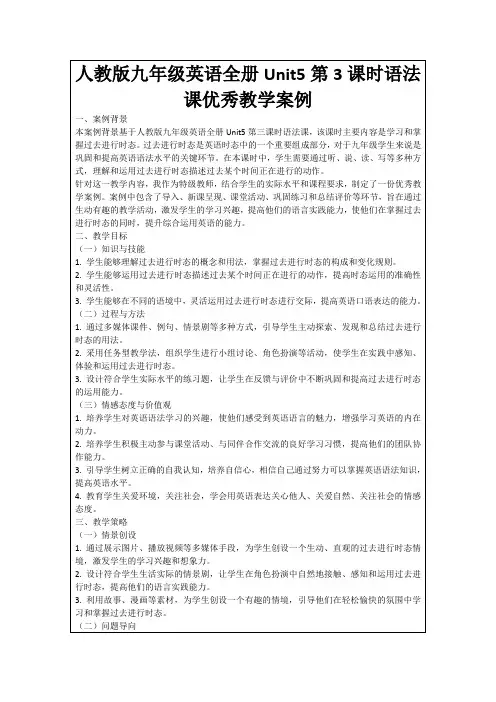
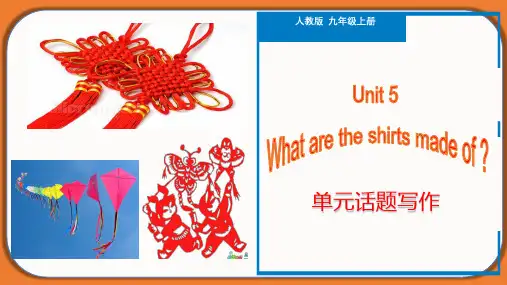

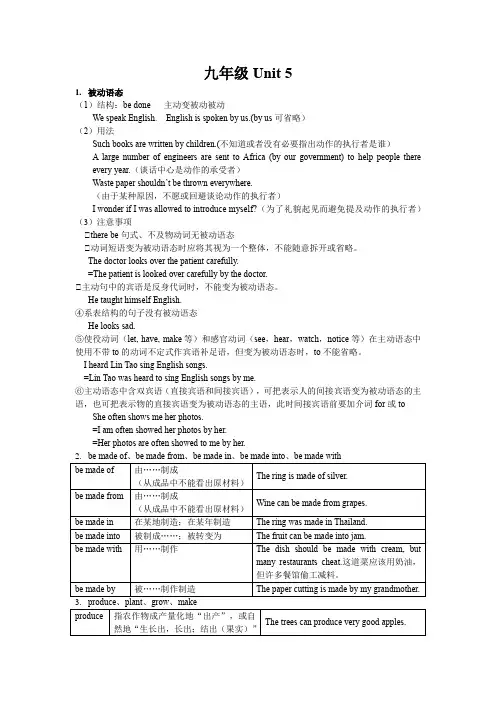
九年级Unit 51.被动语态(1)结构:be done 主动变被动被动We speak English. English is spoken by us.(by us可省略)(2)用法Such books are written by children.(不知道或者没有必要指出动作的执行者是谁)A large number of engineers are sent to Africa (by our government) to help people thereevery year.(谈话中心是动作的承受者)Waste paper shouldn’t be thrown everywhere.(由于某种原因,不愿或回避谈论动作的执行者)I wonder if I was allowed to introduce myself?(为了礼貌起见而避免提及动作的执行者)(3)注意事项①there be句式、不及物动词无被动语态①动词短语变为被动语态时应将其视为一个整体,不能随意拆开或省略。
The doctor looks over the patient carefully.=The patient is looked over carefully by the doctor.①主动句中的宾语是反身代词时,不能变为被动语态。
He taught himself English.④系表结构的句子没有被动语态He looks sad.⑤使役动词(let, have, make等)和感官动词(see,hear,watch,notice等)在主动语态中使用不带to的动词不定式作宾语补足语,但变为被动语态时,to不能省略。
I heard Lin Tao sing English songs.=Lin Tao was heard to sing English songs by me.⑥主动语态中含双宾语(直接宾语和间接宾语),可把表示人的间接宾语变为被动语态的主语,也可把表示物的直接宾语变为被动语态的主语,此时间接宾语前要加介词for或to She often shows me her photos.=I am often showed her photos by her.=Her photos are often showed to me by her.avoid sth/doing sthThe man is so cruel. You should try your best to avoid.Drivers should be careful to avoid some accidents.9.traffic un.____________________,常用heavy,much,a lot of,lots of修饰The traffic is heavy in rush hours.There is always a lot of traffic at this time of a day.traffic lights_____________ traffic jam_________________traffic rules____________ traffic accidents____________10.riserise v.__________,其过去式为________,过去分词为_________The sun rises in the east and sets in the west.12.be famous for______________ be famous as____________be famous to_________________be good for________________ no matter______________ even though__________________ traffic accident_____________ turn...into______________ go on a vacation______________ send out__________________ at festivals_____________ in trouble____________________ rise into__________________ fairy tale_______________ cover with___________________ historical story_____________ by hand_______________ all over the world______________ be used for________________ be used as_____________ be used to do sth______________ be/get used to doing sth_______________ paper cutting_____________练习题一、根据首字母或汉语提示,填写单词。

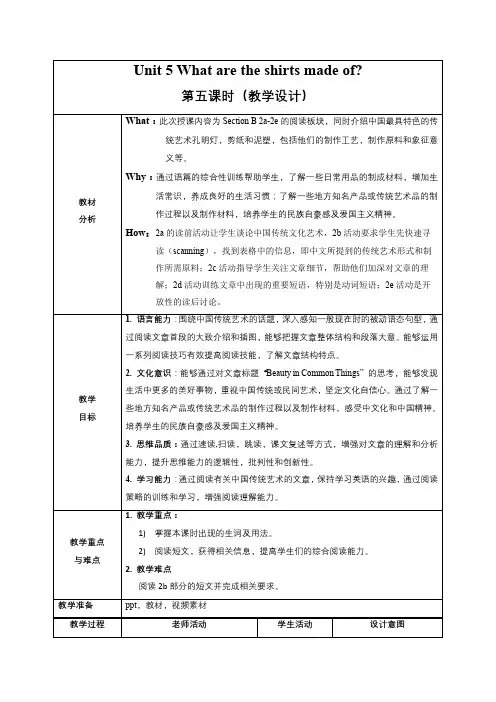
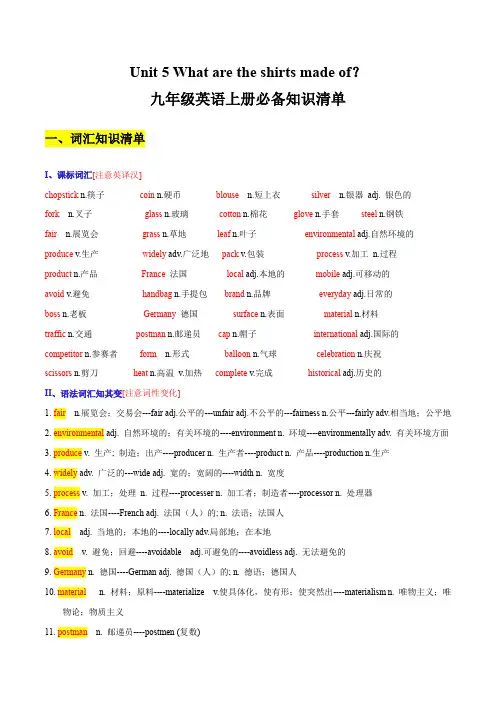

Unit 5 What are the shirts made of?类别课程标准要求掌握的项目单元话题Things made in China重点单词1.chopstick(n.)2.coin(n.)3.fork(n.)4.blouse(n.)5.silver(n.)(adj.)6.glass(n.)7.cotton(n.)8.steel(n.)9.fair(n.)10.grass(n.)11.leaf(n.)12.process(n.)(v.)13.product(n.)14.handbag(n.)15.boss(n.)16.surface(n.)17.material(n.)18.traffic(n.)19.postman(n.)20.cap(n.)21.glove(n.)22.form(n.)23.balloon(n.)24.scissors(n.)25.heat(n.)(v.)26.produce(v.)27.avoid(v.)plete(v.)29.local(adj.)30.mobile(adj.)31.everyday(adj.)32.international(adj.)33.its(adj.)34.lively(adj.)35.widely(adv.)36.France37.Germany重点词组1.be made of(from)2.be made in3.be famous for4.for example5.as far as I know6.by hand7.all over theworld8.be good for9.no matter10.search for11.even though12.in fact13.everyday things14.in the future15.traffic accident16.try to do sth.17.make a kite18.different kindsof19.in life20.turn into21.according to22.in trouble23.be covered with24.paper cutting25.send out26.rise into重点句式1.It was made in Thailand.2.China is famous for tea,right?3.How is tea produced?4.It seems that many people all over the world drink Chinese tea.5.People say that tea is good for both health and business!ura is trying to find out more about kites.7.Where did you go on vacation?8.Each different part of China has its own special formsof traditional art.9.The most common things,from paper to clay to bamboo,areturned into objects of beauty.10.He sent them out to ask for help when in trouble.11.They are made of bamboo and covered with paper.12.They are seen as bright symbols of happiness and goodwishes.13.Paper cutting sounds very easy but it can be difficultto do.14.The paper,usually red,is folded before it is cut withscissors.15.The pieces are usually cute children or livelycharacters from a Chinese fairy tale or historical story.16.It takes several weeks to complete everything.单元语一般现在时的被动语态法第一课时Section A(1a~2d)重点单词chopstick(n.) 筷子coin(n.) 硬币fork(n.) 餐叉;叉子blouse(n.) (女式)短上衣;衬衫silver(n.) 银;银器 (adj.) 银色的glass(n.) 玻璃cotton(n.) 棉;棉花steel(n.) 钢;钢铁fair(n.) 展览会;交易会grass(n.) 草;草地leaf(n.) 叶;叶子produce(v.) 生产;制造;出产widely(adv.) 广泛地;普遍地process(v.)加工;处理(n.)过程重点词组be made of (from )由……制造be made in在……制造be famous for以……而著名for example例如as far as I know据我所知by hand用手工all over the world全世界be good for 对……有好处重点句式It was made in Thailand.它是在泰国制造的。

Unit 5 What are the shirts made of?Section A 1 (1a-2d)一、教学目标:1. 语言知识目标:1) 能掌握以下单词:chopsticks, coin, fork, blouse, silver, glass, cotton, steel, grass,leaf, produce, widely, be known for, process, pack 能掌握以下句型:①—This ring looks nice. Is it made of silver?—Yes, and it was made in Thailand.②What is it made of/from?③China is famous for tea, right?④Where is tea produced in China?2) 能够用英语描述及询问物品的制作材料,正确理解被动语态的用法及句子结构。
2. 情感态度价值观目标:了解一些日常用品的制成材料,增加生活常识,养成良好的生活习惯;了解一些地方知名产品或传统艺术品的制作过程以及制作材料,培养学生的民族自豪感及爱国主义精神。
二、教学重难点1. 教学重点:1) 掌握本课时中出现的生词2) 能够用英语描述及询问物品的制作材料3)正确理解被动语态的用法及句子结构。
2. 教学难点:理解被动语态的用法及句子结构。
三、教学过程Ⅰ. Lead in1. 播放动画片《造纸过程》的视频,让学生们了解这个中国传统发明的情况。
T: Who invented paper first?S1: Cai Lun invented it in Han dynasty.T: What was paper made of then?S2: It was mainly made of bamboo.T: was it easy for people to make paper then?S1: No, it was very difficult then.T: What is paper made of now?S3: It’s mainly made of wood, bamboo, and cotton.…Ⅱ. Presentation1. Present the sentence structure, using the pictures on the big screen:—What’s the golden medal made of?—It’s made of gold.—Is this table made of wood?—No, it isn’t. It’s made of glass.—Is Butter made from meat?—No. It’s made from cream?让学生们学习掌握be made of/from句型的用法,及be made of与be made from的区别。
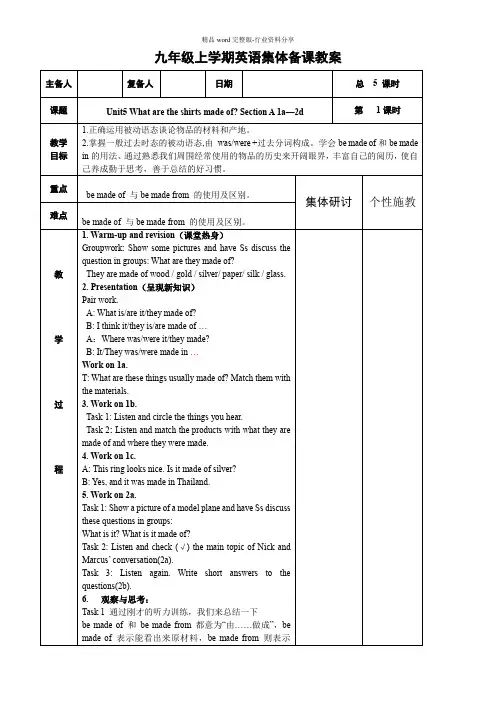

Unit 5What are the shirts made of?Section A 3a—3c一、教学目标1. 熟练掌握下列词汇和短语:product, France, local, avoid, handbag, mobile, everyday, no matter, avoid doing sth.2. 熟练掌握下掌握和运用下列句型:No matter what you may buy, you might think those products were made in those countries.He found it interesting that so many products in the local shops were made in China.He realized that Americans can hardly avoid buying products made in China.Kang Jian thinks it’s great that China is so good at making these everyday things.3. 读懂有关中国制造的产品的英文文章,并能够根据文段中的信息完成相应的阅读任务。
4. 能够谈论产品是由什么制造的以及它们在哪儿制造的。
5. 通过阅读有关在美国购物的文章,了解“中国制造”在世界的地位,增强民族自豪感。
二、教学重点及难点重点:1. 掌握本课时重点词汇、短语和句型表达。
2. 能够阅读有关“中国制造”的文章。
难点:能够运用一般现在时的被动语态谈论产品是由什么制造的以及它们在哪儿制造的。
三、教学准备教师:教学课件;多媒体设备学生:课前预习四、教学过程Step 1 Warming-upLook at some pictures and talk about the questions.【设计意图】利用图片来导入课堂,引出本节课中有关产品制造地的话题及学习相关词汇,为下文3a的阅读作好铺垫。
Unit5 What are the shirts made of?1.Where is tea produced in China?produce (v) 生产;制造;产生;引起辨析: produce与makeproduce:可以表示通过制造而获得产品;也可以表示生产粮食、蔬菜、通过种植而获得产品Eg:We produce more grain this year than we did last year.make:作为“制造”时,一般可以和produce相互换用.但不能表示通过种植而获得的产品Eg:The factory makes/produces cars.David produced/made a fine meal.produce的同根词:producer生产商;制造商production生产;制造;制作product 产品;产物;成果;结果2.For example,Anxi and Hangzhou are widely known for their tea.be known for 以...闻名;为人知晓(相当于be famous for)辨析: be known for与be known asbe known for:表示出名的原因be known as:后接身份、职位等的名词Eg:Hangzhou is known for the West Lake.Lu Xun is known as a writer.辨析:widely与widewidely: adv 广泛地;普遍地(表示抽象的行为和状况)wide: adj宽的;宽广的adv广大地;广阔地(表示抽象的行为和动作)Eg: We were widely different on many questions.They come to a wide river.Open your month wide when you pronounce this sound.3.Kang Jian thinks it’s great that China is so good at making these everyday things.辨析: everyday,every day与dailyeveryday (adj)每天的;日常的every day (adv)每天(一般位于句首或句末)daily (adj/adv)每天的;每天地adj=everyday adv=every day4.The international kite festival is held in...international(adj)国际的①inter是一个前缀,加在adj,v或n前,表示“间;际;相互”Eg:interaction 相互作用interview采访;会见interactive相互作用的②al是adj后缀,常加在名词后.Eg: person-personal music-musical tradition-traditionalnation-national nature-natural education-educational5.He sent them out to ask for help when in trouble.(1)句子分析: when in trouble 是省略句,完整的表达为: when he was in trouble. 当when,while引导的时间状语从句的主语和主句的主语一致,且从句的谓语中含有be动词时,从句的主语和be动词通常可以省略.eg:When (he was)running by the lake,he met his friend.Lily took many photos while (she was)on vacation.(2)in trouble 处于困境中“in+n”结构in danger in silence in surprise6....they slowly rise into the air like small hot-air balloons for all to see. 它们缓慢地升到空中,就像大家看到的小热气球。
李庙中学学案导学预案设计学科English 年级Grade 9 导学教师Mr. Guo 课型Review 课题Unit 5 What are the shirts made of ?(G9)导学目标知识与能力1. Master the key words, phrases and sentences.2. Correct understanding of the use of passive voice and sentence structure. 过程与方法1. Autonomous.2. Explanation.3. Practice情感态度与价值观Enable students to increase their confidence in the big coming exam.导学重点1. The key words, phrases and sentences.2. Correct understanding of the use of passive voice and sentence structure.导学难点Understand the use of passive voice and sentence structure.导学过程导学环节导学任务及导学要求反思与改进Step1 Review the textbookStep2 Expla- nation Students review the textbook and grasp the following contents.1.The key vocabulary and the key phrases.1). 筷子(n. )____________ 2). 银; 银器(n. ) ____________3). 棉; 棉花(n. )____________ 4). 生产; 制造(v. ) ____________5). 加工; 处理(v. ) ___________ 6). 当地的; 本地的(adj. )____________7). 避免; 回避(v. ) ____________ 8). 每天的; 日常的(adj. ) ____________9). 交通(n. ) ____________ 10). 手套(n. ) ____________11). 剪刀(n. ) ____________ 12). leaf(n. )→__________ (复数形式)13). wide(adj. ) →__________ (adv. )广泛地; 普遍地14). German(adj. ) →__________ (n. )德国15). compete(v. ) →__________ (n. )参赛者; 竞争者16). national(adj. ) →__________ (adj. )国际的17). live(v. ) →__________ (adj. )生气勃勃的18). history(n. ) →__________ (adj. )(有关)历史的2. The key sentences about the use of passive voice.The teacher give students careful explanations about some key words, key phrasesand key grammar.I. Careful explanations of some key words.1.produce,grow,plant三个词中意思相对接近的是grow 和plant.这两个词都有种植的意思,但侧重点不尽相同,Grow侧重生长,成长,可以是植物,动物,或其他事物(如企业,野心等),指得是由小到大的整个过程.Plant的种植主要是指栽种,是一个动作,起始点,种棉花,种辣椒,种瓜种豆.Produce的意思是生产,可以是工业上的,农业上的,或雌性生育等.例:1).The dog ______ fast. 狗长得很快。
2).They _____trees on the hill every spring.每年春天他们在山上种树。
3).Tea is ______ in many different areas.茶在不同的地方生产。
2. process:(1)作名词,意思为:工序;过程。
例: Building a car is a long ________ .制造一辆车是一个漫长的过程。
(2)作动词,意思是:加工;处理。
process用作及物动词时,接名词、代词作宾语,可用作被动结构。
用作不及物动词时,常与介词into连用。
例: These leaves are sent for ______. 这些叶子被送去加工。
3. avoid:动词,意思为:回避,避免。
(注意:avoid后若跟动词,只能跟动名词,而不能跟动词不定式。
)例.You should ____ ____ too much chocolate.你应该避免吃太多巧克力。
4. heat: (1)作名词,意思为:热,高温。
例:the ____ of the sun 太阳的热力(2)作动词,意思为:加热,变热。
例: Please ______ me some milk.请给我加热一些牛奶。
plete:(1) 作动词,意思为:完成,后接名词或代词作宾语。
例:They _______ the task last month. 他们上个月完成了这项工作。
(2)作形容词,意思为:全部的;完整的;其副词为:completely,意思为:完全地,彻底地。
例:I trust him __________ .我完全信任他。
6. polish: 作动词,意思为:磨光;修改;润色。
例:Have you ________ your shoes?你擦亮你的鞋了吗?II. Careful explanations of some key phrases.be made of “由……制成”,后接原材料,强调物理变化,能看出原材料be made from “由……制成”,后接原材料,强调化学变化,不能看出原材料be made into “被制成……”,后接成品,强调被制成什么成品Be made out of “由……制成”,后接原材料或另一物品的名称,不强调物理变化或化学变化be made by “被……制造”,后接制作人,强调制作人是谁be made in “在……制造”,后接地点或场所,强调物品的产地根据汉语意思完成下列句子,每空一词。
1). 他的新手机是美国制造的。
His new mobile phone ____ ____ _____ America.2). 这台电视机是由工厂的工人们制造的。
The TV set is ____ _____ the workers in the factory.3). 这些瓶子是塑料做的。
These bottles are ____ _____ plastic. 4). 面包是小麦做的。
The bread is ____ _____ wheat.5). 这种沙拉是用香蕉和苹果做的。
The salad is ____ _____ bananas and apples.2. both...and... :意思为“既......又......”,连接两个并列的成分(可以是名词、形容词、代词等),其否定短语为:neither...nor...,意思为:“既不......也不......”。
注意:both...and...连接两个并列成分做主语时,谓语动词用复数形式;neither...nor...连接两个并列成分做主语时,谓语动词应与nor后的主语在人称和数上保持一致。
例:Both he and I _____ from Beijing. (肯定句)Neither he nor I _____ from Beijing.(否定句)3.Anxi and Hangzhou are widely known for their tea. 安溪和杭州都因为茶而广为人知。
be (well) known/(very) famous for以......(很)闻名”,表示出名的原因be known/famous as “作为......闻名”,表示出名的形式be known/famous to “为……所知晓”,表示出名的范围1).Hong Kong its shopping streets.香港因它的购物街出名。
2).Hong Kong a shopping city. 香港作为一个购物城市出名。
3).Hong Kong people all over the 香港为全世界的人所知晓。
4. no matter what意为“无论什么”,引导步状语从句,相当于whatever。
与no matter what用法类似的还有:no matter what = whatever无论什么no matter who = whoever 无论谁no matter when = whenever 无论什么时候 no matter where = wherever 无论在哪儿 no matter which = whichever无论哪一个 no matter how=however无论怎样无论你看到什么,都不要告诉他人。
无论你去哪里,都不要忘记你的家乡。
无论你是谁,你都不能违反学校纪律。
Step 3PracticeandProgress无论她什么时候来我们学校,她将受到欢迎。
无论你买那一双鞋子,我都同意。
无论你多么擅长英语,你都必须好好学。
III. Sum up the key points about the Comparative and Superlative Forms withadjectives and adverbs.1.被动语态的构成、用法及句式变化。
英语动词有两种语态:主动语态和被动语态用被动语态的几种情形:(1)当主语为动作的承受者,谓语要用被动语态。
(2)当我们不知道谁是动作的执行者,或没有必要说明谁是动作的的执行者,或只需强调动作承受者时,要用被动语态。
被动语态的构成:助动词be+及物动词的过去分词。
助动词be有人称、数和时态变化。
其疑问句、否定句等句式变化,与系动词be的变化规则一致。
2.主动语态变被动语态方法。
第一步:将主动语态的宾语改为被动语态的主语;第二步:将主动语态的谓语改为“be+及物动词的过去分词”结构;第三步:将主动语态的主语改为介词by的宾语,放在谓语之后(有时可省略)。